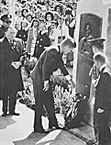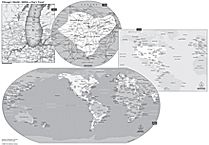| Entries |
| O |
|
O'Hare Airport
|

|
Simultaneously the city of Chicago was looking to expand air travel beyond Midway Airport. In 1944 Ralph Burke, city engineer, designated the Douglas Aircraft plant for use as an additional commercial airport. After retiring to private practice Burke developed a master plan for the airport, including its passenger terminals, highway access and, above all, provisions for later construction of a mass transit link to the Loop. Domestic commercial flights began on a small scale in 1955.
After Burke's death in 1956, Mayor Richard J. Daley selected C. F. Murphy Associates to continue the airport development. Led by partner Carter Manny, Jr., the firm designed a passenger terminal complex comprising four semiautonomous buildings linked by walkways. The terminals have long projections or “fingers” where passengers enplane and deplane. Mayor Daley and President John F. Kennedy dedicated the completed facility on March 23, 1963, formally naming it after the World War II hero Lt. Comdr. Edward O'Hare.

|
When the federal government passed the Airline Deregulation Act of 1978, completing the transformation of flight into mass, long-haul transit, the resulting low, and sometimes idiosyncratic, fare structure greatly increased the number of travelers. In the 1980s this growth undergirded the demand for design and construction of new terminals, an internal surface mass-transportation system or “people mover,” and the extension of a rapid transit line (1984) to the airport. In 1983 Helmut Jahn of Murphy/Jahn designed a new terminal, meeting standards jointly set by the tenant (United Airlines) and the city Department of Aviation. Approximately five years later Perkins & Will completed a new international terminal. By the end of the century the array of buildings, transportation systems, and amenities at O'Hare constituted a city within a city.
The Encyclopedia of Chicago © 2004 The Newberry Library. All Rights Reserved. Portions are copyrighted by other institutions and individuals. Additional information on copyright and permissions.